

WEEK 4: JANUARY 19-25
TOPIC: (433) EROS
Two weeks ago I devoted the “Special Topics” presentation to the subject of near-Earth asteroids. Up until almost the end of the 19th Century all of the over 400 asteroids that had been discovered up to that time orbited within the “main asteroid belt” between Mars and Jupiter, and the astronomers of that era were quite surprised when an asteroid was found that could approach quite closely to Earth. As I discussed in that presentation, during the century and a quarter that has elapsed since then we have discovered that a rather large population of asteroids exists in near-Earth space, and in other regions of the solar system as well.
The asteroid that would create this paradigm shift was discovered on August 13, 1898, by Gustav Witt at the Berlin Observatory in Germany – on a photograph that he had taken of the asteroid (185) Eunike for astrometric purposes – and independently that same night by Auguste Charlois at Nice Observatory in France. Calculations soon revealed that it is traveling in a small, moderately elongated orbit (eccentricity 0.223) with a period of only 1.76 years (21 months) that brings it to 1.133 AU from the sun at perihelion and out to 1.783 AU – somewhat beyond the orbit of Mars – at aphelion. These calculations also revealed that it could approach the Earth moderately closely on occasion, indeed it had passed only 0.152 AU from Earth in January 1894, 4½ years before its discovery. (It was actually only two months past aphelion when discovered.) The newly-discovered asteroid was given the name Eros, after the Greek god of love.
During the first few decades after its discovery Eros would play a key role in our understanding of the overall universe. It comes close enough to Earth such that observers stationed at different locations can determine a measurable parallax, and thus an accurate distance to it. By applying Kepler’s Third Law, and Isaac Newton’s Law of Universal Gravitation (from which Kepler’s Third Law can be derived), it can then be possible to
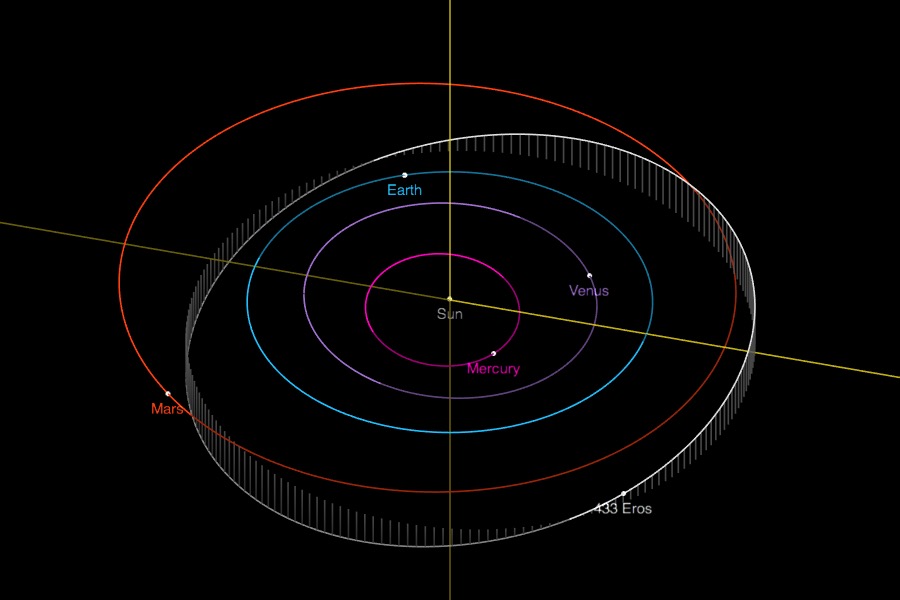
Eros made a moderately close approach to Earth (0.315 AU) in December 1900, and Arthur Hinks of Cambridge University was able to use parallax measurements obtained then to make a reasonably accurate determination of an AU. When Eros made its first post-discovery near-Earth encounter of 0.174 AU in January 1931, British astronomer Harold Spencer Jones (who would soon become Astronomer Royal, the Director of the Royal Observatory in Greenwich) was able to refine the determination of the exact size of an AU to a rather high degree. This determination remained the defining value of an AU until radar measurements in the late 1960s, and then spacecraft measurements, superseded it. The exact value of an AU has now been determined to be 149,597,870.7 km (92,955,807.3 miles).
On January 23, 1975, Eros passed 0.151 AU from Earth, the closest it has come to our planet since its discovery, and in the process it became as bright as 7th magnitude. That encounter allowed for the most accurately-determined values of the rotational period as of that time, as well as of the determination of Eros’ physical dimensions. On the very evening after its closest approach Eros occulted the 4th-magnitude star Kappa Geminorum, one of the earliest and most-publicized events of this nature; the occultation was successfully observed from locations in Massachusetts and Connecticut and among other things this event provided valuable lessons in the art of predicting such occurrences.
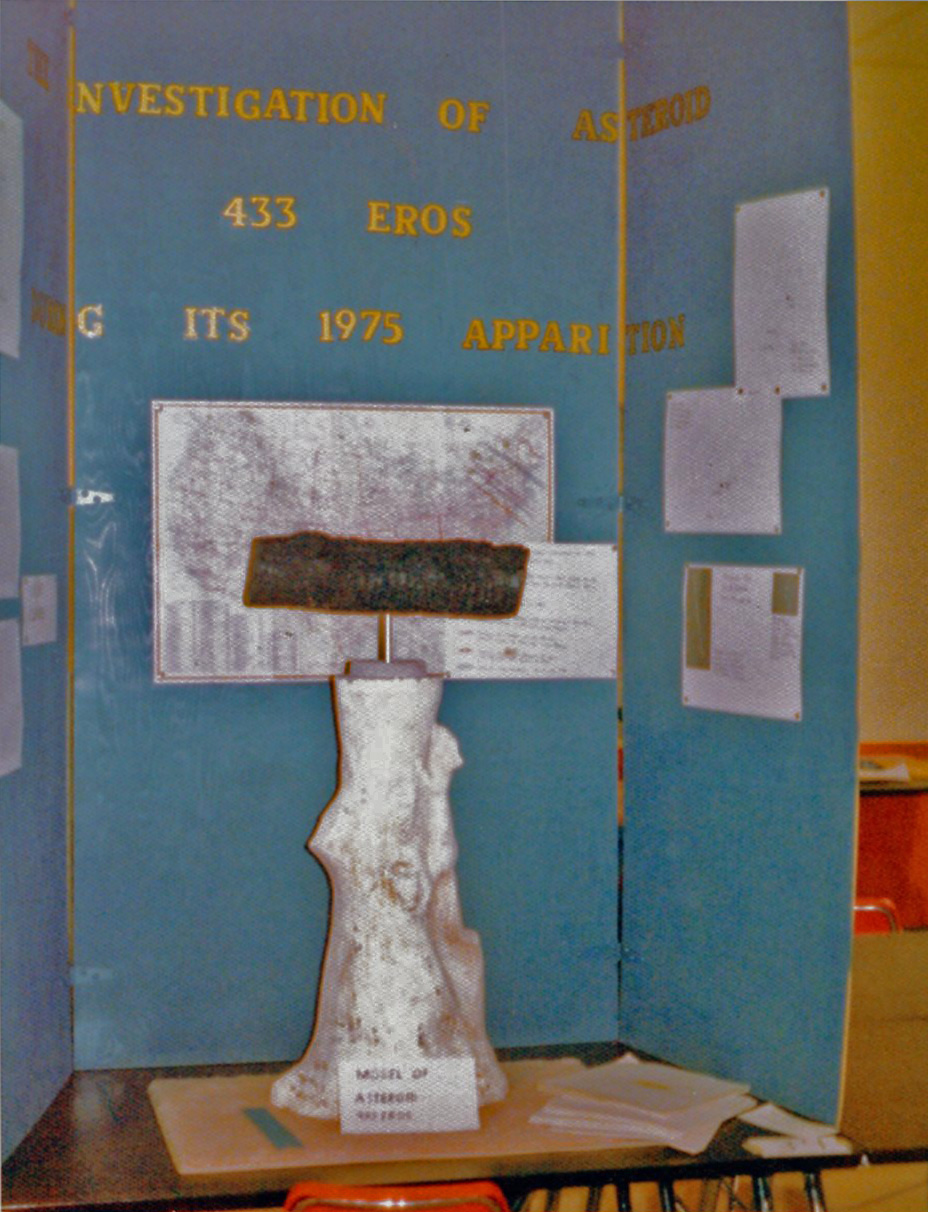
NEAR Shoemaker arrived at Eros in February 2000 and successfully went into orbit around it on February 14. For the next twelve months NEAR Shoemaker orbited Eros in a variety of distances and orbital configurations, in the process extensively photographing and mapping the surface and making numerous scientific measurements. Among many other features, the images show one large crater, since named Charlois Regio, that appears to be due to an impact that took place about one billion years ago; this event appears to be responsible for the many of the large boulders strewn across Eros’ surface as well as the lack of small craters over a significant percentage of the surface. After one year, and as its supply of maneuvering fuel was beginning to run out, NEAR Shoemaker descended to Eros’ surface on February 12, 2001 and performed a soft landing onto the surface – becoming in the process the first spacecraft to make a successful soft landing onto an asteroid or other small body. It continued transmitting data for two more weeks before it was shut down.
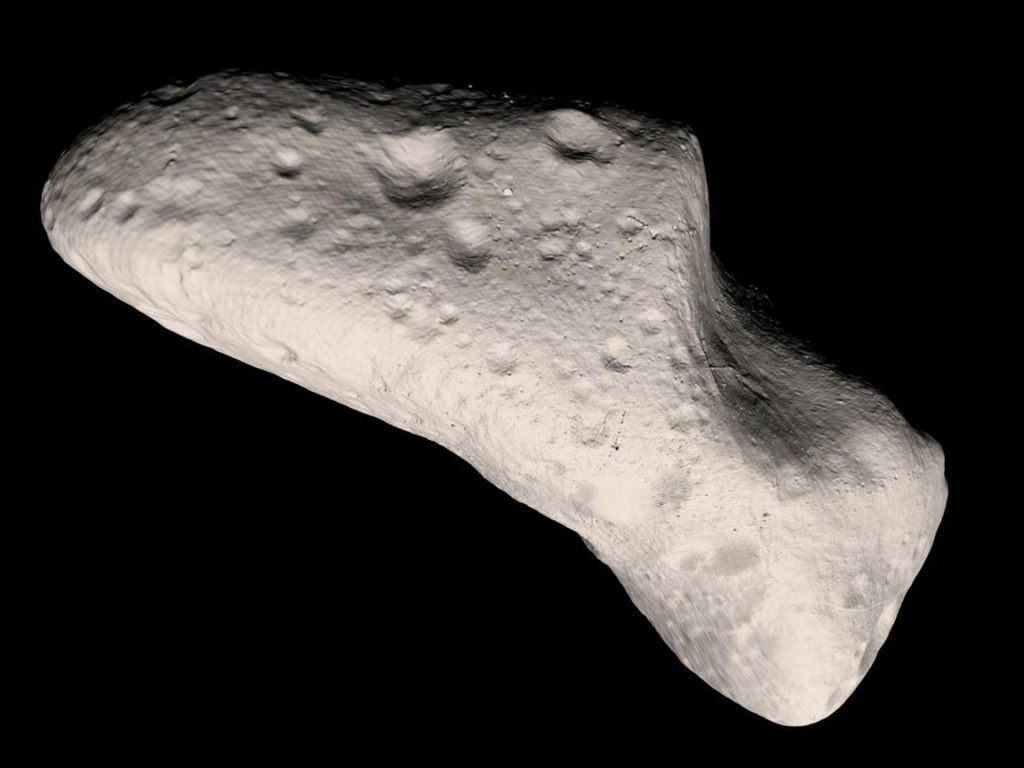
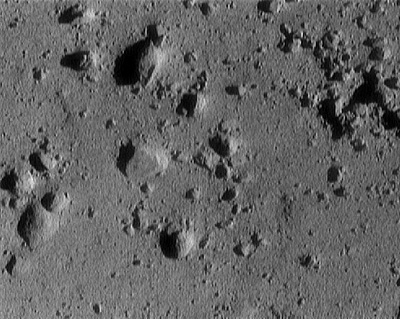 Images of Eros taken by NEAR Shoemaker. Left: February 14, 2000, near the time of orbital insertion. Right: View from 250 meters above the surface, taken during the touchdown descent on February 12, 2001; the field of view is approximately 12 meters across. Both images courtesy NASA.
Images of Eros taken by NEAR Shoemaker. Left: February 14, 2000, near the time of orbital insertion. Right: View from 250 meters above the surface, taken during the touchdown descent on February 12, 2001; the field of view is approximately 12 meters across. Both images courtesy NASA.
Since that time Eros has made two additional somewhat close approaches to Earth: one of 0.179 AU on January 31, 2012 and the other being 0.209 AU on January 15, 2019. It does not approach Earth again for quite some time, although due to its relative closeness and large size it is often nevertheless detectable without much difficulty under appropriate conditions; for example, it will be 13th magnitude, and accessible in the morning sky, when at perihelion in early November this year, and will be 12th magnitude when it is next at opposition, in mid-June 2021, at which time it will be three months away from aphelion.

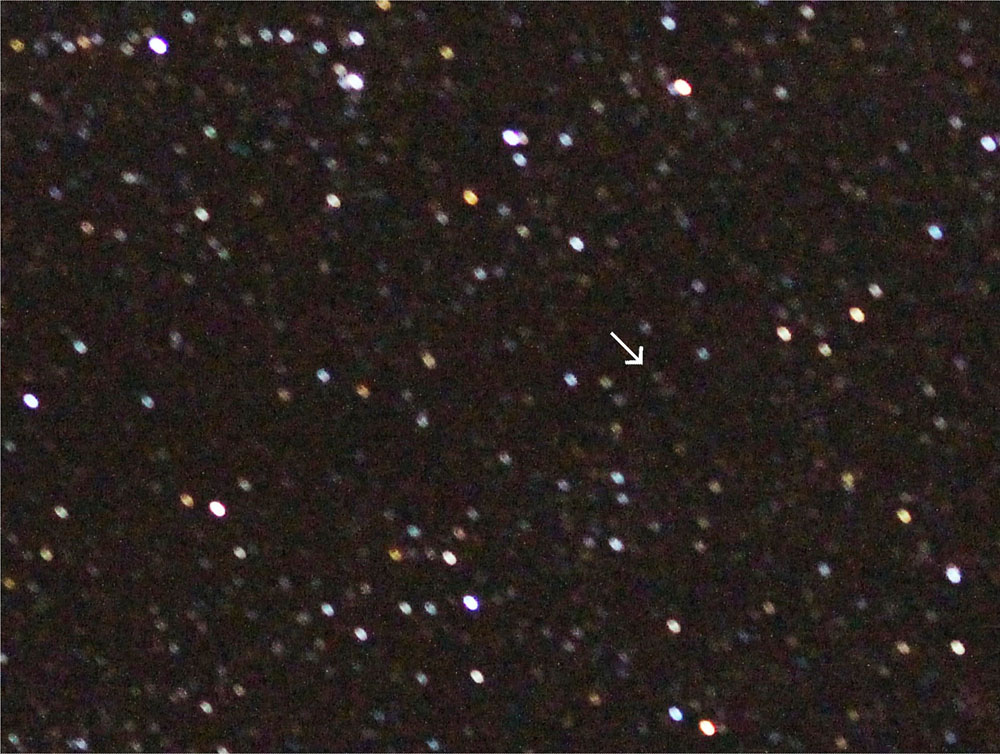 Two images of Eros I took around the time of its 2019 approach to Earth. Left: Las Cumbres Observatory (facility at McDonald Observatory in Texas) image taken on October 10, 2018. Right: Slightly out-of-focus DSLR photograph taken on November 27, 2018. The line of stars known as “Kemble’s Cascade” and the open star cluster NGC 1502 are at the upper left.
Two images of Eros I took around the time of its 2019 approach to Earth. Left: Las Cumbres Observatory (facility at McDonald Observatory in Texas) image taken on October 10, 2018. Right: Slightly out-of-focus DSLR photograph taken on November 27, 2018. The line of stars known as “Kemble’s Cascade” and the open star cluster NGC 1502 are at the upper left.
Eros will next approach Earth again on January 24, 2056, when it will pass 0.150 AU from our planet – marginally closer than its 1975 approach. I would be 97 years old at the time, and when I pointed this out to some of my science-minded friends when I was in High School one of them jokingly replied that perhaps I could do another Science Fair project on it then. I suppose we will have to see about that . . . But, perhaps, the students of that era could perform their own investigations of Eros when it makes its approach. And, perhaps, some of them might even be able to do so by journeying out to it and making observations from its surface . . .
“Special Topics” archive
Ice and Stone 2020 home page
Earthrise Institute home page